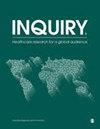在法定预算不变的情况下,医疗保险额的增长和从医生到非医生从业者的支付转移
IF 1.7
4区 医学
Q3 HEALTH CARE SCIENCES & SERVICES
Inquiry-The Journal of Health Care Organization Provision and Financing
Pub Date : 2024-04-26
DOI:10.1177/00469580241249076
引用次数: 0
摘要
数量增加、通货膨胀、法定冻结医生支付以及医疗保险医生收费表的预算中性要求导致通货膨胀调整后的换算系数持续下降。本研究旨在确定按受益人计算的相对价值单位(RVU)数量的增加是否抵消了换算系数的下降和通货膨胀,从而在整体上和各专科中维持了医疗保险对每位受益人的补偿。利用联邦医疗保险 B 部分 100%报销申请(2005-2021 年)的汇总数据,我们计算了各专科名义和通货膨胀调整后每受益人报销额的百分比变化。然后,在保持每位受益人的 RVUs 和转换系数不变的情况下,分别对这些趋势进行调整,以显示预算中性的影响。2005 年至 2021 年期间,经通胀调整后的每位受益人报销额增长了 9.9%;这一趋势体现在每位受益人 RVUs 增长了 64.8%,抵消了经通胀调整后转换系数下降的 33.6%。每位受益人的 RVU 变化在不同临床医师(医师 +45.5% 到非医师执业者 +328.2%)和不同专科(心脏外科 -36.1% 到执业护士 +1106%)之间差异很大。鉴于 RVU 增加、换算系数降低和通货膨胀的综合影响,医生的每位受益人报销额减少了 2.3%,有限执照医生增加了 16.3%,非执业医师增加了 206.5%。总体而言,在预算中立系统中,每位受益人 RVU 量的增加抵消了换算系数的下降。然而,医疗服务提供者类型之间出现了实质性的重新分配,医生的报销额度略有下降,而非医生从业者的报销额度则增加了两倍。某些医生专科,尤其是程序性专科,下降幅度最大。未来的研究应评估特定专科的报销变化对患者获得医疗服务的影响。本文章由计算机程序翻译,如有差异,请以英文原文为准。
Medicare Volume Growth and Shift in Payments From Physicians to Non-Physician Practitioners Under Statutory Budget Neutrality
Volume increases, inflation, statutory freezes in physician payments, and the budget neutrality requirement for the Medicare Physician Fee Schedule have resulted in persistent inflation-adjusted conversion factor decreases. This study aimed to determine if relative value unit (RVU) volume increases on a per beneficiary basis has counteracted conversion factor decreases and inflation to maintain Medicare reimbursement per beneficiary, overall and across specialties. Using aggregated data for 100% of Medicare part B claims (2005-2021), we computed the percentage change in reimbursement per beneficiary, nominal and inflation-adjusted, by specialty. These trends were then adjusted by separately holding constant RVUs per beneficiary and the conversion factor to demonstrate the impact of budget neutrality. Inflation-adjusted reimbursement per beneficiary increased 9.9% over the 2005 to 2021 period; this trend encapsulated a 64.8% increase in RVUs per beneficiary, offsetting a 33.6% inflation-adjusted conversion factor decline. RVU changes per beneficiary varied widely across clinicians (+45.5% for physicians to +328.2% for non-physician practitioners) and by specialty (−36.1% for cardiac surgery to +1106% for nurse practitioners). Given RVU increases, conversion factor decreases, and inflation combined, reimbursement per beneficiary decreased 2.3% for physicians and increased 16.3% for limited-license physicians and 206.5% for non-physician practitioners. Overall, increased RVU volume per beneficiary has offset conversion factor declines within the budget neutral system. However, substantial redistribution has occurred across provider types, with reimbursement declining slightly for physicians while tripling for non-physician practitioners. Certain physician specialties, particularly procedural specialties, have declined most. Future research should assess the impact of specialty-specific reimbursement changes on patients’ access to care.
求助全文
通过发布文献求助,成功后即可免费获取论文全文。
去求助
来源期刊
CiteScore
2.50
自引率
0.00%
发文量
192
审稿时长
>12 weeks
期刊介绍:
INQUIRY is a peer-reviewed open access journal whose msision is to to improve health by sharing research spanning health care, including public health, health services, and health policy.

 求助内容:
求助内容: 应助结果提醒方式:
应助结果提醒方式:


